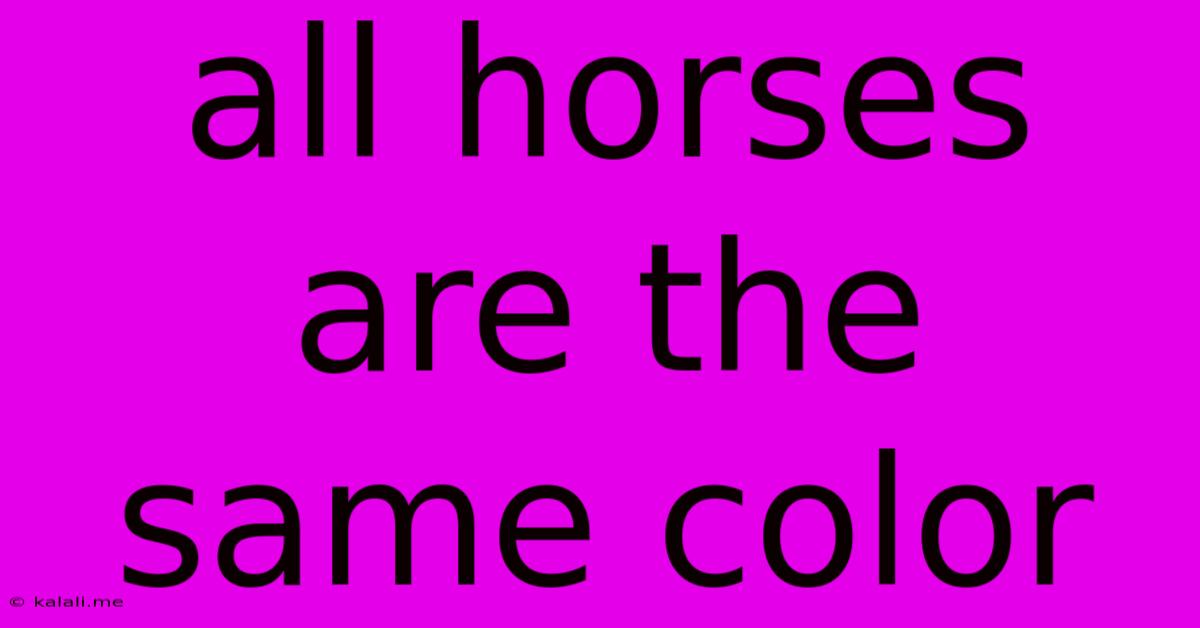All Horses Are The Same Color
Kalali
May 24, 2025 · 3 min read

Table of Contents
All Horses Are the Same Color: A Proof by Induction
This seemingly absurd statement, "all horses are the same color," can be "proven" using a flawed method of mathematical induction. This classic example highlights the importance of carefully examining the base cases and inductive steps in mathematical proofs. Understanding this fallacy can improve your critical thinking skills and even inform your approach to writing compelling and logically sound content. This article will explore the faulty "proof" and explain why it fails.
The Faulty Proof by Induction
The "proof" proceeds as follows:
Base Case: Let's consider a set containing only one horse. In a set with only one horse, all horses in that set are obviously the same color.
Inductive Hypothesis: Assume that for any set of k horses, all horses in the set are the same color.
Inductive Step: Now, consider a set of k+1 horses. We can divide this set into two subsets: a set of k horses and a set containing one horse. By the inductive hypothesis, all horses in the set of k horses are the same color. The remaining single horse is, of course, the same color as itself. Therefore, all horses in the set of k+1 horses are the same color.
Conclusion: By the principle of mathematical induction, all horses are the same color.
Why This Proof Is Wrong
The flaw lies in the inductive step. The "proof" assumes that the two subsets – the set of k horses and the single horse – are completely independent in terms of color. When we move from k horses to k+1 horses, we are implicitly assuming the color of the single horse is the same as the color of the horses in the set of k. There's no guarantee of this. The transition from k to k+1 is not logically sound. The statement only holds true for the base case of one horse.
Applying Critical Thinking to Content Creation
The "all horses are the same color" paradox teaches us a valuable lesson about critical thinking. Just as we need to rigorously examine every step in a mathematical proof, we must similarly scrutinize our arguments and assertions in any form of writing, including blog posts and articles. Avoid making sweeping generalizations without providing sufficient evidence and logical reasoning.
Creating High-Quality, SEO-Friendly Content
Writing high-quality content that ranks well in search engines requires a similar level of rigor. It's not enough to simply string together keywords; your content must be logical, well-structured, and factually accurate. Think of it like a mathematical proof: each section (heading, subheading, paragraph) should build logically upon the previous ones, leading to a clear and persuasive conclusion.
Keywords: Mathematical Induction, Logic, Fallacies, Critical Thinking, Proof, Horse, Color, SEO, Content Writing, Base Case, Inductive Step, Inductive Hypothesis.
By understanding the flaws in flawed logic, we can create more robust, compelling, and ultimately more successful content. This, in turn, improves our search engine optimization and ensures our content stands out from the crowd. Always remember to check your assumptions and ensure that every step in your argument is valid and well-supported.
Latest Posts
Latest Posts
-
How To Repair A Seized Engine
May 25, 2025
-
5 4 Triton Serpentine Belt Diagram With Ac
May 25, 2025
-
How To Separate Fan And Light Switch
May 25, 2025
-
Fallen Angels Names In The Bible
May 25, 2025
-
At The Bottom Or On The Bottom
May 25, 2025
Related Post
Thank you for visiting our website which covers about All Horses Are The Same Color . We hope the information provided has been useful to you. Feel free to contact us if you have any questions or need further assistance. See you next time and don't miss to bookmark.